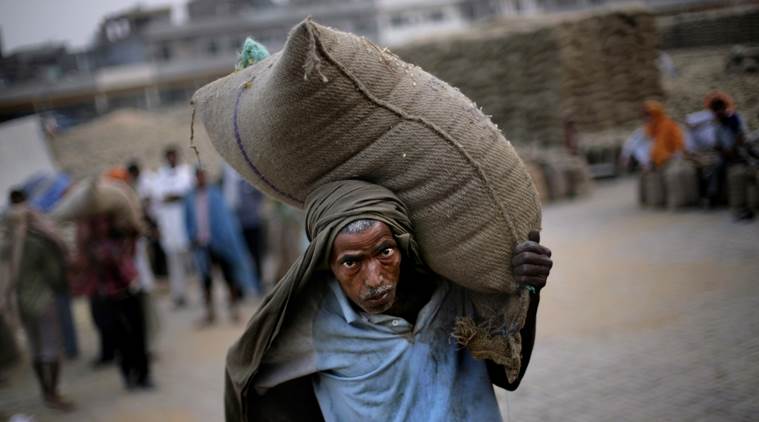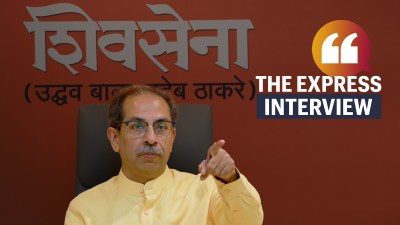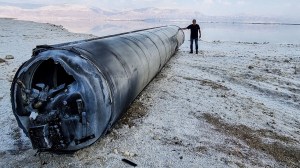- India
- International
First challenge for next govt: Food inflation set to return
The past couple of months have seen prices of a host of farm commodities surge, mainly on the back of drought in large parts of western and southern India, coupled with an early and harsher-than-usual summer.
 A laborer loads a sack of wheat on a truck at a grain market (AP Photo)
A laborer loads a sack of wheat on a truck at a grain market (AP Photo)
THE BJP-LED NDA government’s tenure has been marked by benign food prices. Consumer food inflation has ruled below general retail inflation for 31 months running, from September 2016 to March 2019, while averaging a mere 1.3 per cent year-on-year during this period, as against 3.6 per cent for the latter.
But food inflation could well be the next government’s first challenge, regardless of who heads it. The past couple of months have seen prices of a host of farm commodities surge, mainly on the back of drought in large parts of western and southern India, coupled with an early and harsher-than-usual summer.
On Friday, the average traded price of maize at Davangere (Karnataka) was Rs 2,010 per quintal, compared to Rs 1,120 a year ago. Jowar and bajra were, likewise, selling for Rs 2,750 per quintal (Rs 1,600) at Jalgaon (Maharashtra) and Rs 1,900 per quintal (Rs 1,100) at Chomu (Rajasthan), respectively.
A lower crop — 31.5 million bales in 2018-19, down from 36.5 million bales last year — has led to kapas (raw un-ginned cotton), too, quoting at Rs 5,800 per quintal in Rajkot (Gujarat), from Rs 5,250 at this time last year.
Good for farmers, not consumers
This election, unlike previous ones, has not been fought on inflation. The central government, if at all, has faced flak not for high, but low prices of farm produce during its term. It makes the return of food inflation — bad for consumers, but good for farmers — that much trickier for the next government to handle.
However, it isn’t only coarse cereals and fibres.

According to Vipul Mittal, head (fruits & vegetables) at the online grocery bigbasket.com, the average cost price of horticultural produce has gone up 13-15 per cent year-on-year since March. Thus, tomato prices at Karnataka’s Kolar market are currently averaging Rs 2,000 per quintal, from Rs 580 a year ago, while increasing from Rs 655 to Rs 850 for onion at Lasalgaon (Maharashtra). Even summer season vegetables such as okra, bottle gourd and bitter gourd are wholesaling 36-39 per cent higher than last year; so is radish.

The real problems, though, are in milk. Most cattlefeed ingredients are costing much more now relative to last year. That includes not just maize, but also de-oiled rice bran (up from about Rs 8,950 to Rs 14,350 a tonne), fine rice polish (Rs 16,750 to Rs 20,350), molasses (Rs 3,950 to Rs 7,200) and guar churi/meal (Rs 20,200 to Rs 23,650).
Cottonseed oilcake prices have also risen from Rs 19,000-22,000 to Rs 27,500 per tonne since November-January.
“It’s only a matter of time before all this cost push translates into higher milk prices for consumers,” says R S Sodhi, managing director, Gujarat Co-operative Milk Marketing Federation. The cooperative, better known by its Amul brand, had registered a jump in average milk procurement from 176.5 lakh litres per day (LLPD) in 2016-17 to 204.3 LLPD in 2017-18 and 223 LLPD in 2018-19.
“In this financial year, procurement has so far been 3 per cent lower year-on-year, despite our members union hiking prices from Rs 570-580 per kg of fat in December-January to Rs 630-650 now. Even in North India, procurement prices of buffalo milk with 6.5 per cent fat has soared from Rs 32-33 to Rs 40 per litre in this period,” says Sodhi.
Also Read | Cane payment arrears could hurt the BJP’s prospects in Maharashtra as much as in Uttar Pradesh
While drought-induced fodder and feed shortages are a major cause of cost push and drop in milk procurement, R G Chandramogan, managing director, Hatsun Agro Product Ltd, India’s largest private sector dairy, also attributes it to sustained low prices over the last four years or more. “Not getting good prices for milk has shaken the confidence of farmers. They have been underfeeding their animals or reducing herd sizes, which is bound to affect supply at some point,” he says.
Dairies were forced to slash procurement prices, especially after exports of skimmed milk powder (SMP) from the country collapsed from 129,868 tonnes in 2013-14 to 34,490 tonnes in 2014-15 and 11,476 tonnes in 2017-18. In 2018-19, they recovered slightly to around 45,000 tonnes. The resultant depletion of stocks has, in turn, helped prop up domestic SMP rates from Rs 135-140 per kg to Rs 210 levels in the last six months.
Another commodity that has witnessed improved price sentiment, of late, is sugar. The key driver has been drought in Maharashtra. The state is expected to record 40 per cent lower cane area for the 2019-20 crushing season from October, with farmers — particularly in the Marathwada region and surrounding areas of Solapur, Ahmednagar and Nashik — reducing or not taking up plantings of the “pre-seasonal” (September-October) and “suru” (December-January) crops.
Also Read | The Big Picture: A rural meltdown
“My mill in Osmanabad had roughly 15,000 hectares of cane area last season. For the next season, this may not touch 1,000 hectares. Even the standing crop is being diverted by farmers for fodder,” claims B B Thombre, chairman, Latur-based Natural Sugar and Allied Industries. He predicts that only 6-7 out of Marathwada’s 47 sugar mills will have enough cane to operate in the coming season.
For now, the main ray of hope is the southwest monsoon. The Met Department has forecast aggregate rainfall during June-September to be 96 per cent of its long period average, making it a “near normal” season. But Chandramogan feels that even if the monsoon turns out good and prices are finally looking up, farmers will not be able to step up production overnight, as “agriculture isn’t like switching on or turning off lights”.
Mittal sees the current uptick in food prices as a “healthy and necessary correction”. “It may look inflationary, but the fact is that before March-April, the year-on-year cost increases in fruits and vegetables was in the low single digits or even negative. Farmers, then, couldn’t recover their cultivation costs, which is not sustainable,” he says.
When the NDA government took over in May 2014, annual consumer food inflation was in near double-digits. By end-2016, that was brought down to low single digits by end-2016. Given the associated farm stress caused, it is unlikely that if food inflation returns, the next government — even if headed by Prime Minister Narendra Modi — would be inclined to adopt an overly hawkish approach.
Apr 20: Latest News
- 01
- 02
- 03
- 04
- 05






































